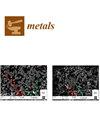Effect of Laser Energy Density on the Properties of CoCrFeMnNi High-Entropy Alloy Coatings on Steel by Laser Cladding
IF 2.5
3区 材料科学
Q3 MATERIALS SCIENCE, MULTIDISCIPLINARY
引用次数: 0
Abstract
High-entropy alloys (HEAs) have emerged as a novel class of materials with exceptional mechanical and corrosion properties, offering promising applications in various engineering fields. However, optimizing their performance through advanced manufacturing techniques, like laser cladding, remains an area of active research. This study investigated the effects of laser energy density on the mechanical and electrochemical properties of CoCrFeMnNi HEA coatings applied to Q235 substrates. Utilizing X-ray diffraction (XRD), this study confirmed the formation of a single-phase face-centered cubic (FCC) structure in all coatings. The hardness of the coatings peaked at 210 HV with a laser energy density of 50 J/mm2. Friction and wear tests highlighted that a coating applied at 60 J/mm2 exhibited the lowest wear rate, primarily due to adhesive and oxidative wear mechanisms, while the 55 J/mm2 coating showed increased hardness but higher abrasive wear. Electrochemical testing revealed superior corrosion resistance for the 60 J/mm2 coating, with a slow corrosion rate and minimal passivation tendency in contrast to the 55 J/mm2 coating. The comprehensive evaluation indicates that the HEA coating with an energy density of 60 J/mm2 exhibits exceptional wear and corrosion resistance.激光能量密度对激光熔覆钢上钴铬铁镍高熵合金涂层性能的影响
高熵合金(HEAs)是一类新型材料,具有优异的机械和腐蚀性能,在各个工程领域都有广阔的应用前景。然而,通过激光熔覆等先进制造技术优化其性能仍是一个活跃的研究领域。本研究调查了激光能量密度对应用于 Q235 基材的 CoCrFeMnNi HEA 涂层的机械和电化学性能的影响。利用 X 射线衍射 (XRD),本研究证实所有涂层都形成了单相面心立方 (FCC) 结构。在激光能量密度为 50 J/mm2 时,涂层的硬度达到 210 HV。摩擦和磨损测试显示,60 J/mm2 的涂层磨损率最低,这主要是由于粘着磨损和氧化磨损机制造成的,而 55 J/mm2 的涂层硬度更高,但磨损率更高。电化学测试表明,与 55 J/mm2 涂层相比,60 J/mm2 涂层的耐腐蚀性更好,腐蚀速度更慢,钝化趋势最小。综合评估表明,能量密度为 60 J/mm2 的 HEA 涂层具有优异的耐磨性和耐腐蚀性。
本文章由计算机程序翻译,如有差异,请以英文原文为准。
求助全文
约1分钟内获得全文
求助全文
来源期刊

Metals
MATERIALS SCIENCE, MULTIDISCIPLINARY-METALLURGY & METALLURGICAL ENGINEERING
CiteScore
4.90
自引率
13.80%
发文量
1832
审稿时长
1.5 months
期刊介绍:
Metals (ISSN 2075-4701) is an open access journal of related scientific research and technology development. It publishes reviews, regular research papers (articles) and short communications. Our aim is to encourage scientists to publish their experimental and theoretical results in as much detail as possible. Therefore, there is no restriction on the length of the papers. The full experimental details must be provided so that the results can be reproduced. Metals provides a forum for publishing papers which advance the in-depth understanding of the relationship between the structure, the properties or the functions of all kinds of metals.
 求助内容:
求助内容: 应助结果提醒方式:
应助结果提醒方式:


